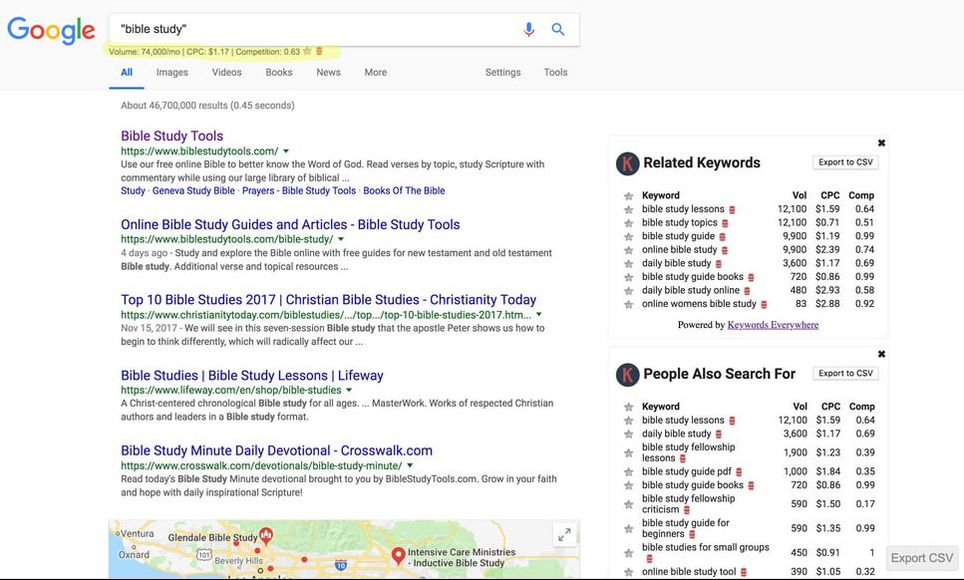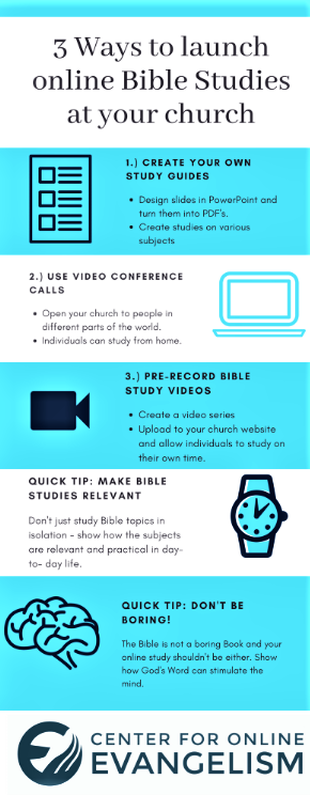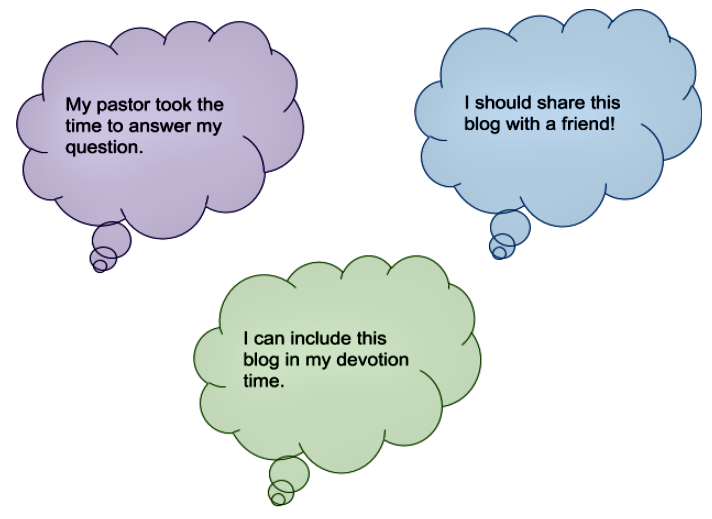Center for Online EvangelismThe Center for Online Evangelism is a missionary project devoted to developing online mission stations. Every follower of Jesus Christ is called to be a missionary.For many of us, when we hear the term “missionary,” we imagine traveling to a third-world country, living without the usual comforts of home, learning a tongue-curling language, and fighting an epic battle against mosquitoes. But that is not the only form of mission work. Mission work is the act of intentionally sharing the Gospel of Jesus Christ. This means that we can use everyday devices like our laptops, smartphones, tablets, and cameras to help someone know of the hope that we have. If you want to be a missionary online but you’re not sure how to go about getting started, here are five important steps to help you: Step 1: Write down your project and stick to it.Your project is a God-given assignment – a task that the Holy Spirit will equip you to complete. Your project or mission work will be based on your gifts, talents, skill set, and experience. But, don’t try to do everything. Examples of mission projects:
The object of online evangelism and mission work is to reach people online and share content that will encourage, inspire, and point them to Christ. We may speak words of encouragement to those whom we meet. “A word spoken in season, how good is it!” Souls are perishing for the lack of personal labor.– E.G. White, Letter 151, 1903. Step 2: Register as an online missionary.Being a part of the Database for Online Missionaries will connect you with other digital disciples and online workers. This database can provide a support system and give you access to resources that could help you serve more effectively. The Center for Online Evangelism is creating a directory for online missionaries. Individuals who intentionally use the internet to share the Gospel are invited to sign up for the directory. Donors and mission supporters can also view this database and back a project. To register, email info@centerforonlineevangelism.org with the subject line "Register for Online Missionary Database." When Jesus had called the Twelve together, he gave them power and authority to drive out all demons and to cure diseases, and he sent them out to proclaim the kingdom of God and to heal the sick: Luke 9: 1,2 NIV Step 3: Choose a prayer partner and prayYour prayer partner will be the person who believes in what God called you to do and they are willing to stand in the gap for you. This is the friend or relative who will pray with you regularly and encourage you when you are tempted to give up. Praying is the highest work of a missionary. It is not a means to an end but the end of our work because it brings us directly in contact with God. Prayer equips us with the strength needed to do the task given by God. A prayer partner helps us formulate specific prayers and plays a crucial role building on our holy faith. As we make Christ our daily companion we shall feel that the powers of an unseen world are all around us, and by looking unto Jesus we shall become assimilated to His image (Pr. 82.1). Step 4: Create a content strategyIt’s important to have a plan. That plan comes in the form of a content strategy. A content strategy is like creating a blueprint or a map for your work. This documented plan encompasses the planning, creation, publishing, distribution, and management (of feedback) of your content. It also includes:
Download a guide to Digital Evangelism for Ministries. Step 5: Improve your skillsWhether you will be writing a blog, producing videos, preaching, or recording a podcast, you need resources that will help you get better at what you do. Assuming that you know it all hinders the work of the Holy Spirit in you. Here are a few things you can do to enhance your proficiencies:
ConclusionBy taking these simple steps, you can be on your way to starting your work as an online missionary. Remember, this is not like a class project or a hobby; this is a sacred work and should be regarded as such.
If you bear in mind the magnitude of your mission task and the significance of sticking with it, you will find that you won’t easily give up during trying moments. Christ commissioned you to do this work. He will also empower you and provide the means to be successful. Sometimes, online mission work can get out of control. Read this article about how digital missionaries can balance online work and spiritual health. Are you interested in being an online missionary? Email info@centerforonlineevangelism.org to register for our Online Missionaries Database. Reposted with permission from centerforonlineevangelism.org.
4 Comments
Jamie Jean Schneider DommDigital Strategist for the North American Division. Amy PrindleThe Center for Online Evangelism is a missionary project devoted to developing online mission stations. This blog post is part of a SEO series created through a collaborative partnership between the Social Media + Big Data department of the North American Division and the Center for Online Evangelism. Whether you’re a conference, union, church, a school, a regional office, a service organization, or a retailer, you may be asking: What is SEO, and what does it have to do with my ministry?One way to understand SEO is to think of the internet as a traditional library, but bigger. All the world’s content is in this library. To find material on a certain topic, you don’t just wander through each aisle. This is a large, multi-story building with shelves from floor to ceiling. If you want to find what you need, and fast, you ask the librarian: Google. You approach Google: “I need snow leopard information.” With that, Google brings you stacks of books. There are travel magazines about zoos that have snow leopards, kids’ picture books of snow leopards, decor magazines about snow-leopard-print area rugs, reference books on animal facts, a few encyclopedias, some National Geographics, and some support manuals for Apple OS X Snow Leopard. You’re overwhelmed, so you say, “Actually, I just want to know where snow leopards live.” Google whisks the previous stack away and returns with a smaller stack of literature. You pick the first book off top, quickly scan through, and find, “Ah—they live in the mountains of Central Asia.” Done. And you only needed to look at the first few pages of the top book. The goal of Google’s search engine is to give searchers exactly what they’re looking for. If it didn’t do that very well, people wouldn’t use their search engine. Google acts as the Great Virtual Librarian, seeking content that is most relevant to what was typed in the search box. The more specific the search query, the more specific the search results. On the other hand, if an author wants their book to make the librarian’s short list for a certain topic, they must demonstrate to the librarian that, for a certain topic, their book is the best match or contains the most reliable information. An author might do this by designing a catchy cover. They might also make the book title contain words that are often used when people ask questions about this topic. They write a subtitle that further specifies what readers will learn, and they craft the back-cover copy as a teaser to draw the reader in. They also have someone write an author bio that positions that author as an expert in the field. The author will also seek to get on bestseller lists, be quoted in various magazines, and even get recommended by other authors. Maybe this author will write forewords to other books and have other prolific authors write the foreword in theirs. The author will be posting ads, participating in interviews, doing readings, etc. The author creates a credible “buzz” and elevates this book as relevant for its topic. The librarian sees all this and brings this book to all readers asking about this topic. And if the library patrons willingly receive it, or even come back to read it again, all the more reason to keep bringing out this book for queries on this topic. The author catered to the librarian by catering to what the readers were looking for. Keep this analogy in mind as we go through this series. Each of those elements represent an online process involved in search engine optimization and, ultimately, the success of your web presence. SEO is all about helping the right people in the “online mission field” find YOUR ministry. There are people out there that are searching for what is already your specialty—a cooking class, a good private school, a small friendly church, a big friendly church, a health seminar, an online Bible study, information about a perplexing Bible verse, how to deal with peer pressure, or how to find help and support when your friends and family aren’t helpful. You may have heard the term “SEO” or “Search Engine Optimization” if you work with websites, content management, social media, or web development. It’s a catch-all term to describe a collection of efforts to make your web presence more prominent in search results after someone types a related phrase into a search engine (most likely Google, but some use Bing, Yahoo, etc.) Because it’s such a widely-applied and ever-evolving process, SEO does not have a set definition in a dictionary—it has several definitions! The most important thing to keep in mind, however, is that: SEO is all about people—their behaviors and preferences—and not just search engines. It’s about your target audience’s needs, desires, and questions, and learning how you can best make the connection so they realize that, yes, you can provide what they need. You are worth their time. Then they either buy from you, subscribe to your content, follow you on social media, join your cause, or come to your event or location (all possible calls-to-action—which will be studied later in this series!). SEO combines some technical work with creative, strategic content work. Often, a complete SEO project involves an SEO specialist, a content strategist (copywriter), and a web developer. However, there are several SEO best practices you can implement yourself as a content manager, communication director, webmaster, or tech-savvy volunteer. The process of SEO can have a big effect on your ministry’s online presence, whether your audience is local or global. SEO is so big in the business world that there is an overabundance of tools and techniques being pushed by various “authorities” in the industry. It can be an overwhelming field to try to learn and keep up with, and it’s often difficult to know who to trust. Even experienced specialists in this industry still find it challenging. That’s why this guide was created to help you through SEO fundamentals, step-by-step, to make sure our Church’s ministries do not miss out on these potentially far-reaching benefits. Click here for the full SEO series and resource guide. External Articles:
External Resources: Jamie Jean Schneider DommDigital Strategist for the North American Division. Amy PrindleThe Center for Online Evangelism is a missionary project devoted to developing online mission stations.  Search Engine Optimization, Online Marketing, Content Strategy, Big Data…why should the Seventh-day Adventist Church prioritize these digital strategies and tools?Most of the world spends hours online each day. Many people have become addicted to research, googling anything they have a question about. They look for maps and location information, check product reviews, read articles, watch videos, post comments, check in with old friends...they’ll even google questions close to their heart—questions they don’t feel comfortable asking close friends or family. Many people may google questions about topics such as spirituality, health, or information to help them through an inner struggle. To be specific, 74,000 people google “Bible study” each month. That’s almost the entire population of Scranton, Pennsylvania. The name “Jesus” is googled 1,500,000 times a month, and “Adventist” 18,100 times a month. This is a huge ministry opportunity—if Adventist websites can rank high in the search results Google displays for these search terms. |
Archives
August 2020
Categories
All
|
- Home
- BLOG
-
RESOURCES
-
RESOURCE MENU
>
- ADVENTIST IDENTITY GUIDELINES
- BIG DATA RESOURCES
- BRANDING, IMAGE & DESIGN RESOURCES
- CHURCH/MINISTRY SPECIFIC RESOURCES
- COPYRIGHT & TRADEMARK BASICS
- COURSES
- EMAIL RESOURCES
- GUIDANCE FOR HIRING SOCIAL MEDIA POSITIONS
- PODCASTS
- REPORTS & CASE STUDIES
- SOCIAL MEDIA RESOURCES
- (SOCIAL) VIDEO RESOURCES >
- TEXTING 4 CHURCHES
- TRACKING & ANALTYICS
- WATCH VIDEOS & TUTORIALS
- WEBSITE TIPS
- SOCIAL MEDIA GUIDELINES
-
RESOURCE MENU
>
- SEO
- Digital Discipleship & Evangelism
- COVID-19 RESOURCES
- eNEWSLETTER













 RSS Feed
RSS Feed